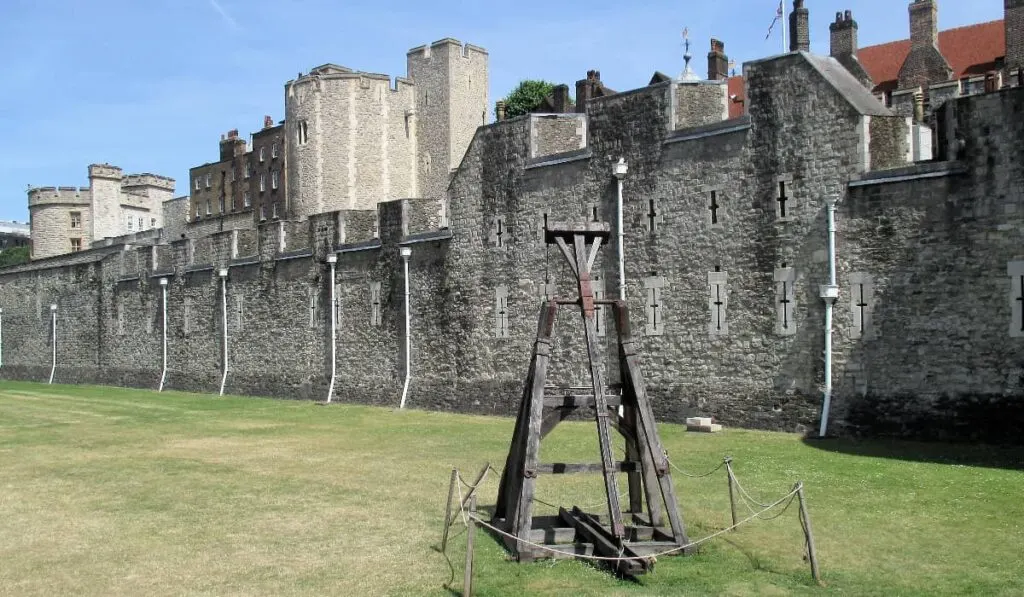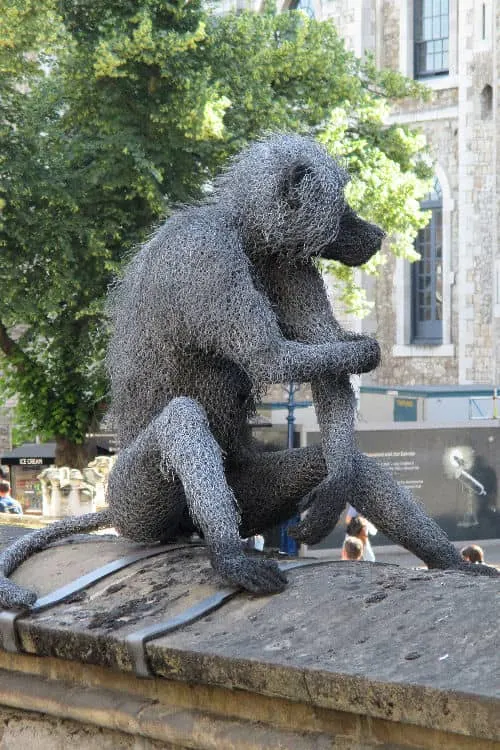
The Tower of London is one of the most iconic landmarks in London, and home to the Royal Crown Jewels. This historic castle, located on the River Thames, has stood for over 900 years and has played a significant role in the country’s history.
The Tower has served as a royal palace, a prison, a treasury, a menagerie, and even a place of execution. If you plan to visit the Tower of London, you can explore its many attractions, including the Crown Jewels, the White Tower, the Bloody Tower, and the famous ravens.
Whether you are interested in history, architecture, or just want to experience one of the country’s most famous landmarks, a visit to the London castle is a must.
History Of The Tower Of London
The Tower has a rich history that spans almost a thousand years. It was founded by William the Conqueror in the late 11th century.
While the original structure was a simple timber fortification, I have enjoyed many visits to the stone replacement castle, built over the course of several centuries.
Initially, the structure was designed to be a symbol of Norman power and to help William the Conqueror consolidate his hold on England.
Over the centuries, the Tower of London was expanded and fortified. It played an important role in the 1381 Peasants’ Revolt and the Wars of the Roses in the 15th century.

During the medieval period, the Tower of London was primarily used as a royal residence. However, it served as a prison, a place of execution, and the royal menagerie, housing lions, tigers, and elephants. Learning about the royal zoo was one of the highlights for me.
Sadly, the Tower was also a place of imprisonment and torture. Many famous figures, including Anne Boleyn, Lady Jane Grey, and Guy Fawkes, were held prisoner in the Tower.
Another notable prisoner was Sir Walter Raleigh, who was imprisoned for 13 years and eventually executed in 1618.
Today, the Tower of London is a UNESCO World Heritage Site, and it is one of the most important historic sites in the world.
By visiting, we experienced its rich history firsthand, and had time to tour the Tower Bridge Exhibition nearby.
Visiting The Tower

When planning a visit to the Tower of London, expect to spend three to four hours touring its exhibits. Tower Hill station provides the closest access to the castle when traveling by London’s underground.
Tickets And Opening Hours
The Tower of London is open every day of the week except for December 24th-26th and January 1st. The opening hours vary depending on the season, so it’s important to check the official website for the most up-to-date information.
As of 2024, the general admission ticket price is GBP 33.60 for adults, with discounts available for groups of 15 or more, disabled visitors, and Tower Hamlet residents.
Guided Tours And Self-Guided Visits

There are several options for exploring the Tower of London, including guided tours and self-guided visits. Guided tours are led by Yeoman Warders, who share fascinating stories and insights into the Tower’s history and inhabitants.
Self-guided visits allow visitors to explore at their own pace, with the aid of an audio guide and informative signs throughout the site.
The guided tours require more time but give a detailed history of the Tower. Self-guided exploration allows freedom to wander and not follow a group. We did the self-guided option and found the exhibits well documented and easy to follow.
What To See At The Tower Of London
The Tower is divided into many smaller exhibits, so exploring them is very easy. Start at the Crown Jewels, the most popular exhibit, or meander through the towers.
Inner And Outer Wards

The Inner and Outer Wards of the Tower of London are surrounded by a defensive wall and contain several buildings and structures. The Inner Ward is the heart of the Tower and is home to the White Tower, the Jewel House, and the Medieval Palace.
Beyond the inner area, the Outer Ward is larger and contains more buildings, including the famous Traitors’ Gate, the Bloody Tower, and the Salt Tower.
The Bloody Tower is where the two young princes, Edward V and Richard of York, were imprisoned and are said to have been murdered.
The Tower Green
Tower Green is a grassy area that is surrounded by historic buildings, including the Queen’s House, the Wakefield Tower, and the Beauchamp Tower.

In the Beauchamp Tower, prisoners had carved graffiti and tally marks into the walls, counting the days of imprisonment. We saw these marks and were amazed they still survived as a reminder of the dark history of the Tower of London.
Within the Lower Wakefield Tower, we saw the cruel torture methods used on the captured. Devices such as manacles, the rack, and the scavenger’s daughter were commonly employed to cause suffering.
Many important events throughout history happened at Tower Green, including the execution of Anne Boleyn, Catherine Howard, and Lady Jane Grey. Tower Green is also home to the Chapel Royal of St. Peter ad Vincula.
The Crown Jewels
The Crown Jewels are a collection of precious objects that have been used by British monarchs for over 800 years. This incredible collection is one of the Tower of London’s most popular attractions and gathers the largest crowds.

We had to queue for around 40 minutes to view the stunning collection of crowns, scepters, and other regalia, which are still used in royal ceremonies today.
The impressive grouping has over 140 items containing over 23,000 precious gems. Cullinan and Cullinan II diamonds are the most famous, cut from a massive 3,106 carat Cullinan Diamond.
The Jewel House is open to visitors throughout the day, but due to its popularity, it’s best to arrive early or book a timed ticket in advance. Do note that photography is not allowed inside the Jewel House.
The White Tower
The White Tower was built in 1078 by William the Conqueror and is the oldest and most iconic building on the site. It was originally intended to be a symbol of Norman power and provide protection for London.
The tower features four turrets, and 4-meter-thick walls. The interior of the tower has been modified over the centuries, but it still retains much of its original architecture and features.

It held a few museums, including the Royal Armories and Line of Kings.
The armory museum houses a fascinating collection of armor, weapons, and artifacts worn not only by noblemen and kings but ordinary soldiers too. I particularly liked the horse armor and couldn’t imagine horses wearing such heavy equipment.
The Line of Kings was created in the 17th century and is one of the oldest museum exhibits. When you visit the Line of Kings, bear in mind tourists have visited this exhibit for over 350 years.
Part of the new exhibit in the White Tower allows visitors to experience the armory in action. We learned how to fire a cannon or tried shooting some arrows. In reality, it’s not nearly as easy as it looks.

Chapel Royal of St. Peter ad Vincula
Within the Tower of London, you’ll find the beautiful Chapel Royal of St. Peter ad Vincula. Dating from the 13th century, it has been the site of many important events throughout history, including the baptism of Queen Elizabeth I.
However, it also serves as the resting place for Anne Boleyn, Catherine Howard, and Lady Jane Grey, three of England’s former Queens.
Meet The Beefeaters
On a day visit to the Tower of London, you won’t want to miss the Beefeater Tours. These tours, led by the Yeoman Warders, are a great way to learn about the history of the Tower and see some of its most famous sights.
Yeoman Warders, also known as Beefeaters, are a group of ceremonial guards who have been responsible for the safety of the Tower of London for over 500 years.
They are also responsible for leading the walkabouts, which are a popular attraction for visitors to the Tower. During the tour, the Yeoman Warders share stories and anecdotes about the history of the Tower, including tales of famous prisoners, executions, and other historical events.

They will also provide insight into the daily life of the guards who have lived and worked at the Tower for centuries.
The Tower of London continues a traditional ritual that’s a secret to most Londoners and visitors. It’s called the Ceremony of the Keys and involves the Yeoman Warders locking up the Tower each night. Tickets to watch the event are free but must be reserved.
Tower Of London Ravens
The Tower of London is famous for its resident ravens. It is said that Charles II was the first to keep ravens at the tower and has now become an integral part of the Tower’s history and culture.
According to legend, if the six Ravens ever leave the Tower, the monarchy will fall. For this reason, there are currently seven ravens at the tower: the required six and one spare.

The Ravens’ names are Poppy, Jubilee, Erin, Rocky, Gripp, Merlina, and Harris. I was fortunate enough to see one hopping around on my visit and was shocked by its size.
These amazing creatures are trained to respond only to the Ravenmaster, who is responsible for their daily care. This role has been in existence since the 17th century.
The current Ravenmaster is Chris Skaife, who has been in the role since 2011. He oversees their breeding program, and often gives talks and tours to visitors.
The Royal Zoo
One of the most fascinating facts we learned was that the Tower once housed a zoo. Starting in the early 1200s by King John, the castle became home to over 60 different animal species.
Over the years, Kings and Queens sustained their fascination for animals. They added tigers, zebras, bears, kangaroos, and even an elephant. As a result, the Royal Beasts continued to live in the Tower.

In 2010, the Historic Royal Palaces commissioned UK artist Kendra Haste to fabricate thirteen sculptures for the Tower of London. These playful wire structures will remain on display. Our favorite were the monkeys, how about yours?
Events And Reenactments
Throughout the year, the London castle hosts a variety of events and reenactments, from medieval jousting tournaments to interactive workshops for children.
These events are a great way to experience the Tower’s history and culture in a fun and engaging way. Although, events are the busiest days at the Tower.

